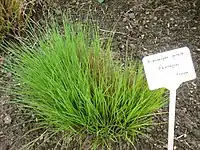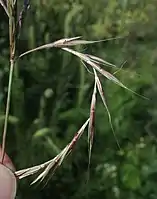Andropogon gerardi
Andropogon gerardi, known commonly as big bluestem, turkeyfoot,[2] tall bluestem,[3] and bluejoint,[4] is a species of tall grass native to much of the Great Plains and grassland regions of central and eastern North America.
| Andropogon gerardi | |
|---|---|
.jpg.webp) | |
| Scientific classification | |
| Kingdom: | Plantae |
| Clade: | Tracheophytes |
| Clade: | Angiosperms |
| Clade: | Monocots |
| Clade: | Commelinids |
| Order: | Poales |
| Family: | Poaceae |
| Subfamily: | Panicoideae |
| Genus: | Andropogon |
| Species: | A. gerardi |
| Binomial name | |
| Andropogon gerardi | |
Description
Big bluestem is a perennial warm-season bunchgrass. It is tolerant of a wide range of soil conditions. The main roots are 6–10 ft (1.8–3.0 m) deep, and the plants send out strong, tough rhizomes, so it forms very strong sod.[3] Depending on soil and moisture conditions, it grows to a height of 1–3 metres (3.3–9.8 ft). The stem base turns blue or purple as it matures.
Big bluestem blooms in the summer and seeds into the fall. The inflorescence (flower cluster) is a raceme of two to six, most commonly three, narrow spike-like racemes alternately arranged along the top of the stem.[5] It somewhat resembles a wild turkey's foot.[3] Each raceme contains pairs of spikelets. Each pair has a stalked spikelet with another stalkless spikelet at the base of the stalk. The stalkless spikelet usually has a fertile, perfect floret (with both female and male parts) and an awn (bristle), and the stalked spikelet is awnless, and is sterile or has a staminate (male) flower.
 New growth in May at the Berlin Botanical Garden
New growth in May at the Berlin Botanical Garden_in_flower_Sand_Lake_Wetland_Management_District_01_(14635029543).jpg.webp) The flower cluster in bloom
The flower cluster in bloom The spike-like raceme bent to show the pairs of spikelets that it is made up of.
The spike-like raceme bent to show the pairs of spikelets that it is made up of.
Ecology
Big bluestem is a mid-successional grass in prairie and other grassland ecosystems. It grows in tall, dense stands that can out-compete other plant species.[6] The stands grow until disturbance interrupts their spread. It is shade intolerant and is adapted to fire.
It is a larval host to the Arogos skipper, Byssus skipper, cobweb skipper, common wood nymph, Delaware skipper, and the dusted skipper.[7]
Uses
Agriculture
The grass and its variants are good forage for horses and cattle and can also be cut and used for hay. The grass is high in protein. While not considered the highest quality native forage found in the United States, it has long been considered a desirable and ecologically important grass by cattle ranchers and rangeland ecologists.[8][9]
Landscaping
Big bluestem is cultivated by specialty plant nurseries for its drought tolerance and native status. It is often grown for wildlife gardens, natural landscaping, and grassland habitat restoration projects.
Symbols
Andropogon gerardi is the state grass of Illinois[11] and Missouri[12] and the official prairie grass of Manitoba.[13]
Nomenclatural notes
USDA GRIN rejects the spelling gerardii and provides reasoning for gerardi as being the correct spelling for the specific epithet of this taxon.[2] Andropogon gerardii still makes appearances in various literature, including USDA publications.[14]
References
- Summa Pl. 6: 16. 1792. "Andropogon gerardii". International Plant Names Index (IPNI). Royal Botanic Gardens, Kew. Retrieved 2018-07-13.
- "Andropogon gerardi". Germplasm Resources Information Network (GRIN). Agricultural Research Service (ARS), United States Department of Agriculture (USDA). Retrieved 12 December 2017.
- Uchytil, R. J. (1988). "Andropogon gerardii". Fire Effects Information System (FEIS). US Department of Agriculture (USDA), Forest Service (USFS), Rocky Mountain Research Station, Fire Sciences Laboratory. Retrieved 20 June 2013 – via https://www.feis-crs.org/feis/.
- "Andropogon gerardii". Integrated Taxonomic Information System.
- Hilty, John (2016). "Big Bluestem (Andropogon gerardii)". Illinois Wildflowers.
- "Big bluestem". Grow Native!. Missouri Prairie Foundation. Retrieved 2018-07-31.
- The Xerces Society (2016), Gardening for Butterflies: How You Can Attract and Protect Beautiful, Beneficial Insects, Timber Press.
- Hintz, Roger L.; Harmoney, Keith R.; Moore, Kenneth J.; George, J. Ronald; Brummer, Edward C. (1998). "Establishment of Switchgrass and Big Bluestem in Corn with Atrazine" (PDF). Agronomy Journal. 90 (5): 591–596. doi:10.2134/agronj1998.00021962009000050004x. Retrieved 17 January 2017.
- Kaiser, Jerry (1 March 2011). "Big Bluestem and Indiangrass for Biomass Production by Variety Selection and Establishment Methods for Missouri, Illinois, and Iowa" (PDF). Natural Resources Conservation Service, United States Department of Agriculture. Retrieved 17 January 2017.
- Zhang, Ke; Johnson, Loretta; Prasad, P.V. Vara; Pei, Zhijian; Wang, Donghai (2015). "Big bluestem as a bioenergy crop: A review". Renewable and Sustainable Energy Reviews. 52: 740–756. doi:10.1016/j.rser.2015.07.144.
- "Illinois State Prairie Grass — Big Bluestem (Andropogon gerardii)". State Symbols Web Exhibit. Illinois State Museum. Archived from the original on 2012-10-20.
- "State Symbols of Missouri - The State Grass". Office of the Secretary of State of Missouri.
- "Vote for Manitoba's Official Prairie Grass Emblem". Manitoba Provincial Grass Campaign Committee. 2008.
- "Andropogon gerardii". Natural Resources Conservation Service PLANTS Database. USDA.
Further reading
- Everitt, J.H.; Drawe, D.L.; Little, C.R.; Lonard, R.I. (2011). Grasses of South Texas. Lubbock, Texas: Texas Tech University Press. ISBN 978-0-89672-668-0.
External links
| Wikimedia Commons has media related to Andropogon gerardii. |
| Wikispecies has information related to Andropogon gerardi. |
